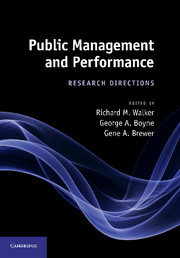Book contents
- Frontmatter
- Contents
- List of figures
- List of tables
- Notes on contributors
- 1 Introduction
- 2 Extending goal ambiguity research in government: from organizational goal ambiguity to programme goal ambiguity
- 3 Budgets and financial management
- 4 Organizational structure and public service performance
- 5 Red tape: the bane of public organizations?
- 6 Managerial networking, managing the environment, and programme performance: a summary of findings and an agenda
- 7 Public service motivation and performance
- 8 Organizational diversity and public service performance
- 9 Performance management: does it work?
- 10 Strategy: which strategic stances matter?
- 11 Methods
- 12 Conclusion: enriching the field
- Index
- References
4 - Organizational structure and public service performance
Published online by Cambridge University Press: 05 July 2014
- Frontmatter
- Contents
- List of figures
- List of tables
- Notes on contributors
- 1 Introduction
- 2 Extending goal ambiguity research in government: from organizational goal ambiguity to programme goal ambiguity
- 3 Budgets and financial management
- 4 Organizational structure and public service performance
- 5 Red tape: the bane of public organizations?
- 6 Managerial networking, managing the environment, and programme performance: a summary of findings and an agenda
- 7 Public service motivation and performance
- 8 Organizational diversity and public service performance
- 9 Performance management: does it work?
- 10 Strategy: which strategic stances matter?
- 11 Methods
- 12 Conclusion: enriching the field
- Index
- References
Summary
Introduction
Organizational structures provide the pervasive foundation for achieving coordination and control within an organization, influencing and being influenced by a host of different inputs, outputs and outcomes. One of the key functions for public managers is therefore the creation and maintenance of activities that can provide structural support for a host of other characteristics that are central to the pursuit of organizational goals, such as values and routines (O’Toole and Meier 1999). The relationship between structure and performance is thus a timeless concern for students of public management. Indeed, some might say it constitutes the foremost object of the theory and practice of bureaucracy. Woodrow Wilson (1887) claimed that ‘philosophically viewed’ public administration was chiefly concerned with ‘the study of the proper distribution of constitutional authority’ (213). Classical organizational theorists regarded bureaucratic structure, and its relationship with decision making and behaviour, as key to understanding organizational effectiveness (e.g. Gulick and Urwick 1937; Simon 1976; Weber 1947).
Organizational structure comprises two main sets of characteristics. First, the broad ‘structural’ features that define the physical milieu in which organization members interact, such as the overall size of an organization and the ratio of administrators to production workers. Second, the ‘structuring’ activities managers undertake in order to deliberately shape the behaviour of organization members, such as the relative decentralization of decision making and the specialization of job tasks (Dalton et al. 1980). Although ‘structural’ characteristics are likely to influence organizational outcomes in the public sector, public managers have far less discretion than their private sector counterparts over these elements of organizational structure.
- Type
- Chapter
- Information
- Public Management and PerformanceResearch Directions, pp. 89 - 109Publisher: Cambridge University PressPrint publication year: 2010
References
- 9
- Cited by



